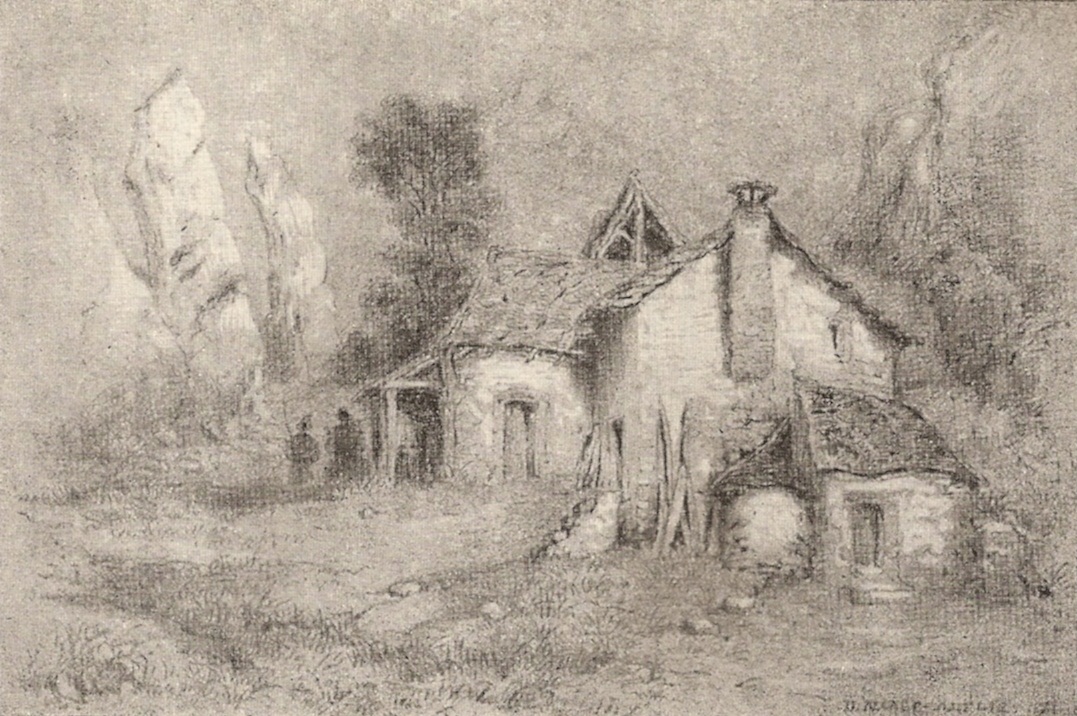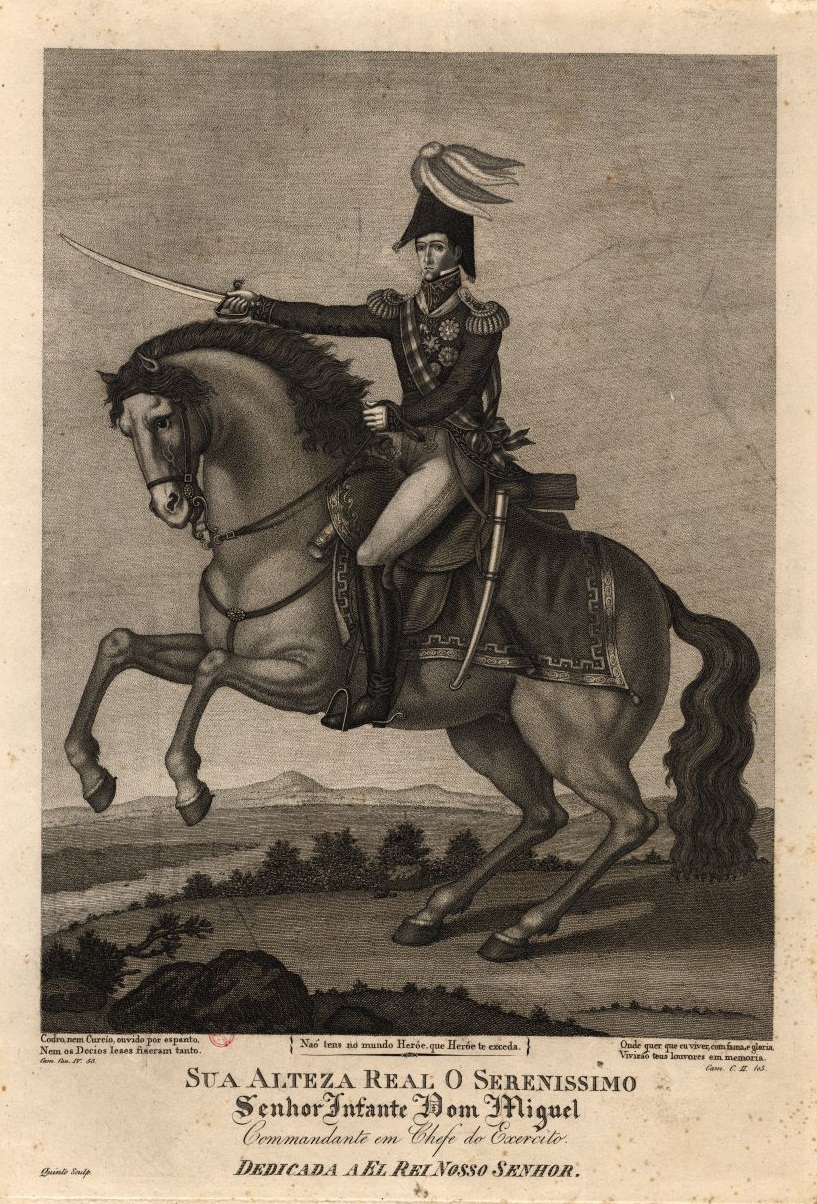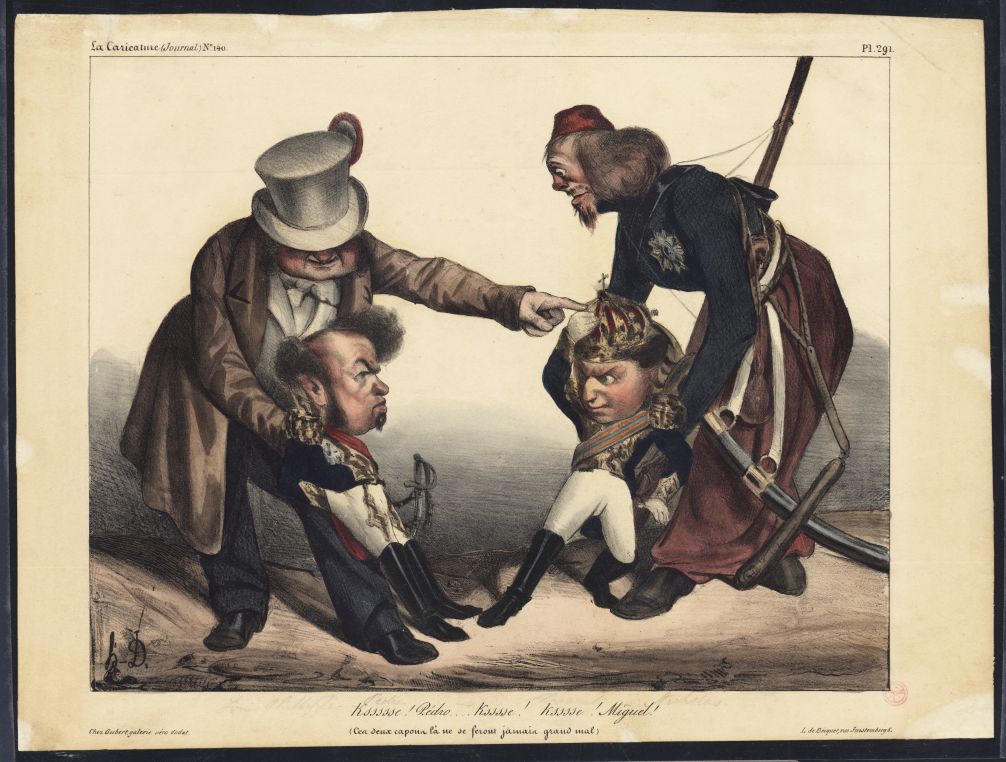|
Pedro I Of Brazil
''Don (honorific), Dom'' Pedro I (12 October 1798 – 24 September 1834), known in Brazil and in Portugal as "the Liberator" () or "the Soldier King" () in Portugal, was the founder and List of monarchs of Brazil, first ruler of the Empire of Brazil from 1822 to 1831 (under the name of Pedro I) and List of Portuguese monarchs#House of Braganza (1640–1910), King of Portugal in 1826 (under the name of Pedro IV). Born in Lisbon, Pedro was the fourth child of King Dom John VI of Portugal and Queen Carlota Joaquina, and thus a member of the House of Braganza. When the country was Invasion of Portugal (1807), invaded by French troops in 1807, he and his family fled to Portugal's largest and wealthiest colony, Brazil. The outbreak of the Liberal Revolution of 1820 in Lisbon compelled Pedro I's father to return to Portugal in April 1821, leaving him to rule Brazil as regent. He had to deal with challenges from revolutionaries and insubordination by Portuguese troops, all of whi ... [...More Info...] [...Related Items...] OR: [Wikipedia] [Google] [Baidu] |
List Of Monarchs Of Brazil
The monarchs of Brazil ( Portuguese: ''monarcas do Brasil'') were the imperial heads of state and hereditary rulers of Brazil from the House of Braganza that reigned from the creation of the Brazilian monarchy in 1815 as a constituent kingdom of the United Kingdom of Portugal, Brazil and the Algarves until the republican coup d'état that overthrew the Empire of Brazil in 1889.Bandeira, Moniz. ''Casa da Torre de Garcia d'Avila''. Editora Record, 2000, pp. 423–425 The coast of the territory which would become known as Brazil was first explored by Portuguese navigators on 22 April 1500. This territory was subsequently colonized by the Portuguese crown. Since the transfer of the Portuguese court to Brazil in 1808, colonial rule had de facto ended. On 16 December 1815, Prince Regent John, the future king John VI, raised Brazil to the status of a kingdom, thus making his mother, Maria I, the reigning queen, the first monarch of Brazil. The next year, 20 March 1816, John succee ... [...More Info...] [...Related Items...] OR: [Wikipedia] [Google] [Baidu] |
Duke Of Braganza
The title Duke of Braganza () in the House of Braganza is one of the most important titles in the peerage of Portugal. Starting in 1640, when the House of Braganza acceded to the throne of Portugal, the male heir of the Portuguese Crown were known as Duke of Braganza, along with their style Prince of Beira or (from 1645 to 1816) Prince of Brazil. The tradition of the heir to the throne being titled Duke of Braganza was revived by various pretenders after the establishment of the Portuguese Republic on 5 October 1910 to signify their claims to the throne. History of Dukedom Feudal dukes The Duke of Braganza holds one of the most important dukedoms in Portugal, see Duchy of Braganza (''Bragança''). Created in 1442 by King Afonso V of Portugal for his uncle Afonso, Count of Barcelos (natural son of King John I of Portugal), it is one of the oldest fiefdoms in Portugal. The fifth Duke of Braganza (Teodósio I, b. 1510) is especially important to historians of interna ... [...More Info...] [...Related Items...] OR: [Wikipedia] [Google] [Baidu] |
Princess Maria Amélia Of Brazil
Dom (title), Dona Maria Amélia (1 December 1831 – 4 February 1853) was a princess of the Empire of Brazil and a member of the Brazilian branch of the House of Braganza. Her parents were Emperor Dom (title), Dom Pedro I of Brazil, Pedro I, the first ruler of Brazil, and Amélie of Leuchtenberg. The only child of her father's second marriage, Maria Amélia was born in July Monarchy, France after Pedro I abdicated the Brazilian throne in favor of his son Dom Pedro II of Brazil, Pedro II. Before Maria Amélia was a month old, Pedro I went to Portugal to restore the crown of the eldest daughter of his first marriage, Dona Maria II of Portugal, Maria II. He fought a successful war against his brother Miguel of Portugal, Miguel I, who had usurped Maria II's throne. Only a few months after his victory, Pedro I died from tuberculosis. Maria Amélia's mother took her to Portugal, where she remained for most of her life without ever visiting Brazil ... [...More Info...] [...Related Items...] OR: [Wikipedia] [Google] [Baidu] |
Miguel I Of Portugal
'' Dom'' Miguel I (26 October 1802 – 14 November 1866), known by several nicknames, was the King of Portugal between 1828 and 1834. He was son of King John VI and Queen Carlota Joaquina. Following his exile as a result of his actions in support of absolutism in the April Revolt (Abrilada) of 1824, Miguel returned to Portugal in 1828 as regent and fiancé of his niece Queen Maria II. As regent, he claimed the Portuguese throne in his own right, since according to the so-called Fundamental Laws of the Kingdom his older brother Pedro IV and therefore the latter's daughter had lost their rights from the moment that Pedro had made war on Portugal and become the sovereign of a foreign state (Brazilian Empire). This led to a difficult political situation, during which many people were killed, imprisoned, persecuted or sent into exile, and which culminated in the Portuguese Liberal Wars between authoritarian absolutists and progressive constitutionalists. In the end Miguel ... [...More Info...] [...Related Items...] OR: [Wikipedia] [Google] [Baidu] |
Liberal Wars
The Liberal Wars (), also known as the Portuguese Civil War () and the War of the Two Brothers () was a civil war in Portugal that lasted from May 1828 to May 1834, fought between liberal progressive constitutionalists (led by former King Pedro IV) and conservative traditionalists (led by King Miguel I) over the country's system of government and royal succession. Embroiled parties included the Kingdom of Portugal, Portuguese rebels, the United Kingdom, France, the Catholic Church, Spain and Russia. Roots of the conflict The death of King John VI in 1826 created a dispute over royal succession. While Dom Pedro, the Emperor of Brazil, was the king's oldest son, his younger brother Miguel contended that Pedro had forfeited his claim to the throne by declaring Brazilian independence and by declaring war on the Kingdom of Portugal, therefore violating the succession rules mentioned in the Fundamental Laws of the Kingdom. Pedro briefly entitled himself King Pedro IV of P ... [...More Info...] [...Related Items...] OR: [Wikipedia] [Google] [Baidu] |
Don (honorific)
The terms Don (in Spanish language, Spanish and Italian language, Italian), Dom (in Portuguese language, Portuguese), and Domn (in Romanian language, Romanian), are honorific prefixes derived from the Latin language, Latin ''Dominus'', meaning "lord" or "owner". The honorific is commonly used in Spain, Portugal, and Italy, as well as in the Spanish-speaking world and Portuguese-speaking world, as well as some other places formerly colonized by Spain or Portugal. The feminine equivalents are (), (), (Romanian) and (). The term is derived from the Latin : a master of a household, a title with background from the Roman Republic in classical antiquity. With the abbreviated form having emerged as such in the Middle Ages, traditionally it is reserved for Catholic clergy and nobles, in addition to certain educational authorities and persons of high distinction. Spanish-speaking world In Spanish, although originally a title reserved for royalty, select nobles, and church hierarch ... [...More Info...] [...Related Items...] OR: [Wikipedia] [Google] [Baidu] |
Catholic Church In Brazil
The Brazilian Catholic Church, or Catholic Church in Brazil, is part of the worldwide Catholic Church, under the spiritual leadership of the Pope in Rome, and the influential National Conference of Bishops of Brazil (), composed of over 400 primary and auxiliary bishops and archbishops. There are 44 ecclesiastical provinces, which have 275 dioceses, eparchies, ordinariates, and territorial prelatures in Brazil. The primate of Brazil is Dom Sérgio da Rocha. The Catholic Church is the largest denomination in the country, where 119 million people, or 56.75% of the Brazilian population, were self-declared Catholics in 2022. These figures made Brazil the single country with the largest Catholic community in the world.Country Studies"Brazil - Roman Catholicism" source: Rex A. Hudson, ed. ''Brazil: A Country Study''. Washington: GPO for the Library of Congress, 1997.Scalon, Maria Celi"Catholics and Protestants in Brazil" ''America Magazine''. 18 August 2003. According to Rome's ''A ... [...More Info...] [...Related Items...] OR: [Wikipedia] [Google] [Baidu] |
Monument To The Independence Of Brazil
The Monument to the Independence of Brazil () is a granite and bronze monument located in the Independence Park in São Paulo, Brazil. It is also known as the Ipiranga Monument () or the Altar of the Fatherland (). The monument is located on the banks of the Ipiranga Brook, on the historic site where prince regent Pedro (later emperor as Pedro I) proclaimed the independence of the country on 7 September 1822. The monument was designed and built by Italian sculptor Ettore Ximenes (1855–1926) and Italian architect Manfredo Manfredi (1859–1927) to celebrate the first centennial of the Brazilian Independence in 1922. The crypt A crypt and chapel is located inside the monument. The crypt was built in 1972 to house the remains of Emperor Pedro I (also King of Portugal as Pedro IV) and his wives, Maria Leopoldina of Austria and Amélie of Leuchtenberg. The crypt is consecrated as a Catholic chapel, as demanded by the then head of the Brazilian imperial family, Pedro Henrique ... [...More Info...] [...Related Items...] OR: [Wikipedia] [Google] [Baidu] |
Royal Pantheon Of The House Of Braganza
The Pantheon of the House of Braganza (Portuguese language, Portuguese: ''Panteão da Dinastia de Bragança''), also known as the Pantheon of the Braganzas (''Panteão dos Bragança''), is the final resting place for many of the members of the House of Braganza, located in the Monastery of São Vicente de Fora in the Alfama district of Lisbon, Portugal. The pantheon's burials have included List of Portuguese monarchs, Portuguese monarchs, List of monarchs of Brazil, Brazilian monarchs, a List of Romanian monarchs, Romanian monarch, List of Portuguese consorts, queen consorts of Portugal, and notable Infantes of Portugal, among others. History The Pantheon was created under orders from Ferdinand II of Portugal, transforming the old refectory of the monastery into the burial place it is today. The majority of the tombs are located on the sides of the pantheon, and are simple marble boxes with spaces of four tombs. If the tomb is of a monarch, it has a crown engraved in gold on the ... [...More Info...] [...Related Items...] OR: [Wikipedia] [Google] [Baidu] |
Pedro I's Heart
The heart of the Brazilian emperor Pedro I of Brazil, Pedro I has been preserved since his death in 1834. The organ is kept in a glass jar, with formaldehyde, in the . The container is kept in an urn, locked under lock and key. The heart is considered a relic by the Portuguese government. Pedro I's remains are buried in São Paulo, in the crypt of the Monument to the Independence of Brazil, Monument to the Independence. By decision of the monarch himself, as one of his last requests in life, the heart was separated and kept in Portugal. Pedro I asked that the heart be preserved in Porto because of the relevance of the city in the Liberal Wars, civil war for the Portuguese throne between Pedro I (known as Pedro IV in Portugal) and his brother Miguel I of Portugal, Miguel. After the emperor's death from tuberculosis in September 1834, a series of royal and ecclesiastical agreements were made so that, in February 1835, the heart was finally sent to Porto, kept in a gilded silver vas ... [...More Info...] [...Related Items...] OR: [Wikipedia] [Google] [Baidu] |
Kingdom Of Portugal
The Kingdom of Portugal was a Portuguese monarchy, monarchy in the western Iberian Peninsula and the predecessor of the modern Portuguese Republic. Existing to various extents between 1139 and 1910, it was also known as the Kingdom of Portugal and the Algarves after 1415, and as the United Kingdom of Portugal, Brazil and the Algarves between 1815 and 1822. The name is also often applied to the Portuguese Empire, the realm's overseas colonies. The nucleus of the Portuguese state was the County of Portugal, established in the 9th century as part of the ''Reconquista'', by Vímara Peres, a vassal of the Kingdom of Asturias, King of Asturias. The county became part of the Kingdom of León in 1097, and the Counts of Portugal established themselves as rulers of an independent kingdom in the 12th century, following the battle of São Mamede. The kingdom was ruled by the Portuguese House of Burgundy, Afonsine Dynasty until the 1383–85 Crisis, after which the monarchy passed to the Hous ... [...More Info...] [...Related Items...] OR: [Wikipedia] [Google] [Baidu] |
Queluz Palace
The Palace of Queluz (, ) is an 18th-century palace located at Queluz, a city of the Sintra Municipality, in the Lisbon District, on the Portuguese Riviera. One of the last great Rococo buildings to be designed in Europe,Lowndes, p. 179. the palace was conceived as a summer retreat for King Joseph I's brother, Peter of Braganza, later to become husband and king ''jure uxoris'' (as King Peter III) to his own niece, Queen Maria I. It eventually served as a discreet place of incarceration for Maria I, when she became afflicted by severe mental illness in the years following Peter III's death in 1786. Following the destruction of the Palace of Ajuda by fire in 1794, Queluz Palace became the official residence of the Portuguese Prince Regent John, and his family, and remained so until the royal family fled to the Portuguese colony of Brazil following the French invasion of Portugal (1807).IPPAR Work on the palace began in 1747 under Portuguese architect Mateus Vicente de Oliveira. ... [...More Info...] [...Related Items...] OR: [Wikipedia] [Google] [Baidu] |







